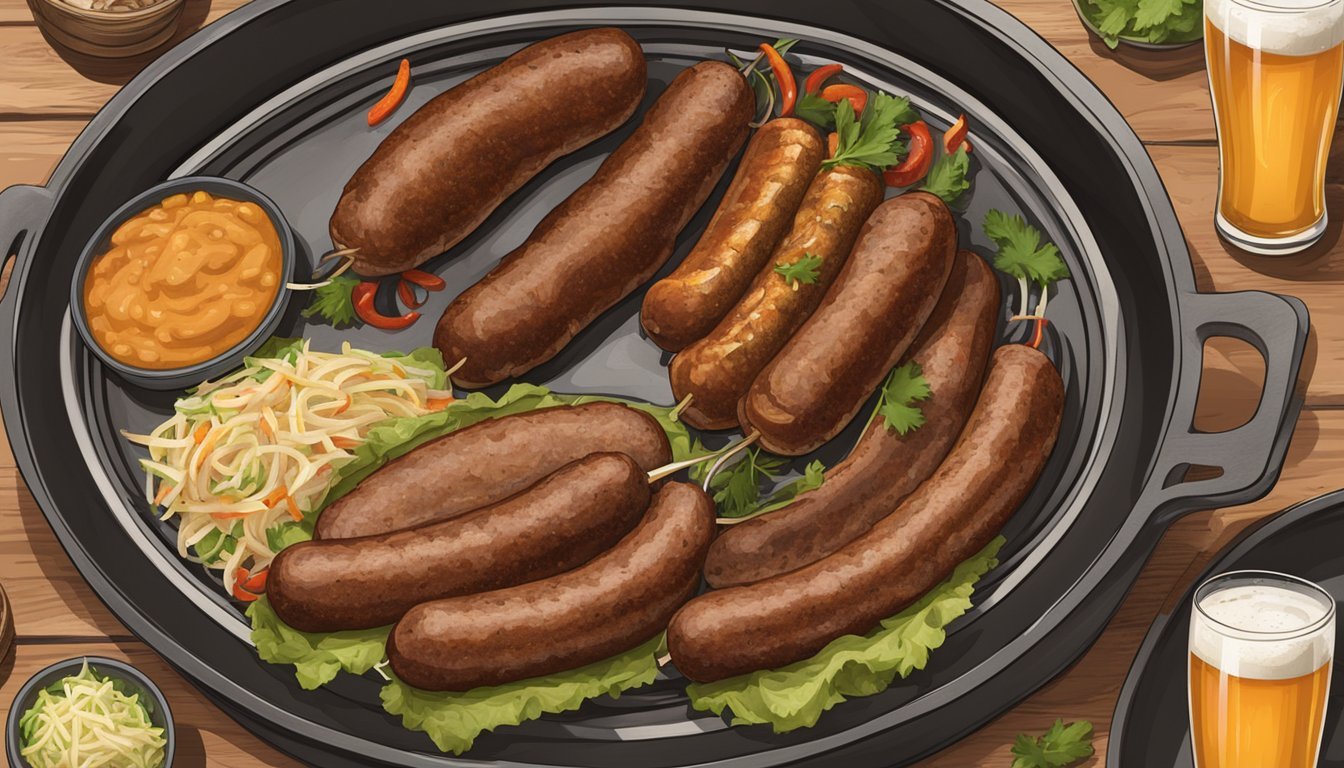The Influence of German Cuisine on Texas Fusion Cuisine
Blending Traditions
The culinary scene in Texas is a rich tapestry reflecting the state's diverse cultural heritage, a heritage notably shaped by the influence of German settlers who brought their distinctive flavors and food traditions. German immigrants began arriving in Texas during the 1830s, integrating their cuisine with local ingredients and culinary practices. This fusion has left a significant impact on what is now recognized as Texas fusion cuisine, creating a food culture that is at once uniquely Texan and reverent to its German roots.
Among the most prominent contributions of German cuisine (What Wine Pairs Perfectly With German Cuisine) to the Texan culinary landscape are the techniques and traditions associated with baking and meat preparation. Bakeries across Texas still produce European-style breads, pastries, and cakes, illustrating the endurance of German baking practices. Additionally, Texas barbecue, now a centerpiece of its food culture, owes some of its development to the German approach to butchery and sausage making. This integration is most evident in the variety of smoked meats (What wine goes well with smoked meats?), especially sausages that combine German craftsmanship with Texan flavors.
The assimilation of German culinary techniques has not occurred in isolation but rather as part of a broader intermingling of ethnic cuisines that have shaped the state's gastronomic identity. While German cuisine's influence remains pronounced in the realms of baking and meat preparation, its fusion with other culinary traditions continues to evolve, contributing to the dynamic and innovative spirit of Texas cuisine.
Historical Context of German Influence in Texas
In the 19th century, German immigrants significantly shaped Texas's cultural and culinary landscape through their traditions and adaptation to local ingredients.
German Immigration Waves
The mid-19th century witnessed large-scale German immigration to the United States due to socio-economic challenges in Germany. Texas, offering ample land and economic opportunity, attracted many Germans, resulting in notable population influxes. Central Texas Hill Country saw the establishment of towns such as Fredericksburg and New Braunfels by these European settlers.
Important Years:
1840s-1850s: Peak decades of German immigration to Texas.
Settlement and Cultural Integration
Upon settling in Texas, Germans incorporated their cultural customs into local practices, especially in cuisine. They opened bakeries, breweries, and meat markets, leaving a lasting impact on food preferences. Czech immigrants also shared similar culinary traditions, contributing to Texas's fusion cuisine. The melding of cultures led to a unique blend, with smoked sausages becoming a staple symbolizing this cultural integration.
Integration in Cuisine:
Smoked sausages
Bakeries serving traditional breads
Breweries crafting German-style beers
Culinary Fusions and Evolutions
Texas fusion cuisine is a compelling gastronomic tapestry woven with threads from diverse culinary traditions. Foremost among these are the robust flavors of Mexican and German cuisines, which have combined in fascinating ways to form what we know today as Tex-Mex cuisine and other Texan culinary delights.
The Advent of Tex-Mex Cuisine
Tex-Mex cuisine emerged as a distinctive food genre deeply ingrained in Texas's cultural milieu. Initially, this cuisine was marked by the interplay of native Mexican dishes with Texan ingredients and tastes. Staples such as tacos, enchiladas, and tamales were adapted to suit local palates, often with the addition of regional spices and flavors. As a result, Tex-Mex has grown into a beloved and universally recognized style that exemplifies the fusion spirit of Texas dishes.
Incorporation of German Culinary Elements
German settlers in Texas contributed significantly to the region's culinary evolution by introducing their baking techniques and recipes. Their influence is particularly apparent in pastry and baked goods available throughout Texas. For example:
Pastries: German-inspired sweets are prevalent, often incorporating local pecans and other native ingredients.
Meat Dishes: Robust German flavors found a natural ally in Texan-style meats, as evidenced in smoke-infused barbecue (What wine goes well with barbecue?) items like beef brisket. (What wine goes well with beef brisket?)
The synthesis of German culinary practices with Texan and Mexican ingredients forged a unique dining landscape where European and American flavors harmonize seamlessly.
Signature Dishes and Ingredients
The fusion of German and Texan cuisines has given rise to a distinctive food culture in Texas, characterized particularly by its meats and bakery items. German immigration has left a lasting imprint on Texan cuisine, leading to a rich array of dishes that have become staples in the state.
Texas Barbecue and German Meats
German settlers in Texas brought with them a tradition of butchery and sausage-making which heavily influenced the Texan barbecue scene. Barbecue, a Texan staple, often includes beef brisket which is slow-smoked over wood; a cooking method consistent with German smoking techniques. Sausages, another crossover, range from bratwurst to local varieties, often incorporating a mix of beef and pork with bold spices. These meats are frequently accompanied by sauerkraut and pickles, providing a tangy contrast to the rich, smoky flavors.
Key German-Texas barbecue meats include:
Beef Brisket
Various sausages (e.g., Bratwurst)
Smoked pork chops (Kasseler)
Breads, Pastries, and Sides
German influence extends into bakery products with a variety of breads and pastries that hold a special place in Texan food. Sweets like strudel, with its flaky pastry and sweet fruit fillings, have been adopted and adapted in Texas kitchens. Kolaches, a type of pastry that has its origins in Central Europe, has become particularly popular, often filled with locally available ingredients such as cheese, jalapeños, or sausage. Savory sides include German-style potato dishes and breaded, fried meats such as schnitzel, which have been embraced in Texan cuisine, sometimes with a local twist like substituting the traditional pork for chicken.
Examples of German-Texas bakery items and sides:
Bread: Pumpernickel, Rye, Sourdough
Pastries: Strudel, Kolaches
Sides: Potato salad, Breaded Schnitzel
Modern Texas-German Culinary Scene
Texas cuisine has been notably enriched by the German influence, combining traditional German recipes with local Texan twists. The modern landscape of this fusion can be found in various restaurants and celebrated through numerous community events.
Restaurants and Chefs
Major Texas cities like Austin, Dallas, and San Antonio host restaurants that showcase the melding of German and Texan flavors. Chefs have embraced this heritage, offering menus filled with items like schnitzel burgers and bratwurst tacos. In Central Texas, the legacy of the German immigrants who arrived in the 1800s is still present in eateries where sausage-making techniques are revered and practiced with a reverence for tradition.
Austin: Renowned for culinary innovation, the city's chefs often experiment by incorporating local ingredients like jalapeños into classic German dishes.
Dallas: Some chefs here trace their culinary roots to German ancestors and honor them by creating authentic German dishes, occasionally with a Southern drawl.
San Antonio: With a strong German cultural history, restaurants often feature Oktoberfest staples year-round, fusing them with local Tex-Mex cuisine.
Festivals and Community Events
Festivals and events act as a testament to Texas's German food heritage. Annual celebrations like Oktoberfest are held across the state, from Fredericksburg to New Braunfels, attracting both locals and tourists. They serve a dual purpose: to preserve the cultural exchange that has thrived for over a century and to introduce new generations to the flavors and traditions of the Texas-German community.
Fredericksburg: Known for its German heritage, this town's festivals feature authentic German cuisine alongside local wines.
New Braunfels: Here, community events often blend German traditions with Texan hospitality, showcasing smoked meats and hearty breads.
Statewide: Oktoberfest celebrations across Texas highlight both traditional German fare and local adaptations, such as Texan craft beers paired with German-style sausages.
The Role of Ingredients and Cooking Techniques
In Texas fusion cuisine, German influence is particularly evident in the use of specific ingredients and the adoption of cooking methods such as smoking and grilling that add a unique flavor profile to dishes.
Smoking and Grilling Methods
Smoking is a technique deeply rooted in German culinary traditions and has been embraced in Texas cuisine. It chiefly involves the smoked sausage, a staple of German food, which is given new life in Texas with the use of local woods like hickory and mesquite. This imparts a distinctive taste that has become synonymous with Texas barbecue.
Woods Used: Hickory, Mesquite, Oak
Techniques: Slow-smoking, Hot-smoking
The grill is another beloved tool, often employed to prepare meats. The German technique of cooking over an open flame is a thread woven throughout the fabric of Texas grilling habits, with a focus on simplicity and enhancing the meat's natural flavors.
Grilling Methods: Direct, Indirect
Focus: Charred exterior, Tender interior
Spices and Seasoning Variations
German cuisine's often subtle spicing finds a bolder counterpart in Texas. Salt remains a fundamental seasoning, but the introduction of German spices has been augmented by more robust Texan flavors such as cayenne pepper and chili powder. These additions bring heat and depth to the dishes.
Commonly Used German Spices: Mustard, Marjoram
Adopted Texan Spices: Cayenne Pepper, Chili Powder
Garlic and onions, integral to both German and Texan cuisines, provide a pungent base that underpins the complex taste profiles in fusion dishes, offering a common ground for the melding of these two culinary worlds.
Essential Ingredients: Garlic and Onions
Preparation: Chopped, Sliced, or Whole
Through these cooking techniques and seasoning variations, Texas fusion cuisine demonstrates a marriage of German and local traditions, where meticulous smoking and grilling methods join forces with a bold spice palette to create a distinguishable and robust gastronomic heritage.
Socio-Cultural Impact and Identity
German immigrants have greatly influenced Texan culture, notably through their culinary heritage, which has been embraced and adapted to the local Texan identity. This cross-pollination of culture is evident in Texas fusion cuisine.
Cuisine as a Cultural Expression
Culinary traditions serve as a testament to the socio-cultural integration that occurs when different groups coexist. German cuisine in Texas, with its emphasis on meats such as sausage and its unique style of smoked meats, melded with Texan ranch culture to create a distinct Texan-German fusion cuisine. This fusion reflects the shared values and identity of Texas, which prides itself on a rich history of barbecue and meat preparation techniques. Community festivals such as Oktoberfest in Fredericksburg provide a space for cultural expression through food, dance, and shared customs, strengthening the state's bond with its German roots.
Cultural Entities:
Culture: German-Texan fusion manifested through culinary adaptation.
Traditions: Integrating German meat preparation techniques with Texan barbecue.
Culinary Heritage: Reflects the synergy of German and Texan culinary traditions.
Language and Local Identity
The German language's influence persists in regional names and culinary terminology within Texas, symbolizing a lasting imprint on local identity. Towns with German names like New Braunfels and Boerne have become venues where culinary traditions intermingle with local customs. Here, one finds specialized menus offering items such as Bratwurst, Schnitzel, and Strudel alongside Texan barbecue, maintaining a dialogue between the two cultures. This linguistic preservation extends to food-related gatherings and menus, fostering a sense of pride and community amongst residents who celebrate their unique hybrid identity.
Cultural Entities:
Language: German terms used in culinary contexts (e.g., Kraut, Pretzel).
Identity: German-Texan communities maintaining heritage and pride through cuisine.
Influence on Other Culinary Traditions
The mergence of German cuisine with the Texan culinary landscape has notably influenced Southern cooking and enriched the region’s food traditions with new flavors and dishes.
Impact on Southern Cuisine
German immigrants to Texas brought with them a repertoire of cooking techniques and uses of ingredients that have left a lasting impact on Southern cuisine. One prominent example is Texas barbecue, a mainstay of Southern food, which has drawn from German methods of smoking and seasoning meats. This has resulted in dishes such as smoked beef brisket, where the German influence is evident. Additionally, side dishes complementary to this style of cooking, such as potato salad, showcase German roots adapted to local tastes and ingredients, often featuring mashed potatoes rather than traditional German potato preparations.
Exchange with Mexican and Native American Foods
The exchange between German and Mexican culinary traditions has forged unique Tex-Mex flavors. Germans introduced bread-making techniques leading to the creation of pastries like strudels, but they also adopted Mexican staples such as tortillas and incorporated them into their cuisine. Conversely, Mexican dishes have been adapted using ingredients commonly found in German cooking, resulting in hybrid foods such as Tex-Mex sausages that combine local spices like cumin and chili powder with traditional German sausage-making methods.
German settlers also learned from Native American food practices. They included native ingredients into their cooking, which can be seen in dishes that use locally sourced corn—a fundamental element in both Native American and Southern cuisine—with adaptations like cornbread emerging as a blend of these culinary worlds.
Innovations and Future Directions
Texas fusion cuisine continues to evolve through unique creativity and development, with chefs utilizing bold, flavorful local ingredients to redefine food experiences.
Fusion Cuisine Trends
Chefs in Texas are blending German culinary traditions with local Texan flavors, creating innovative dishes that resonate with the state's diverse palate. These chefs leverage their skills to marry schnitzel and sauerkraut with smoked brisket or jalapeños, illustrating a fearless approach to cuisine. Moreover, fusion trends are leaning toward incorporating heritage recipes with contemporary techniques. Texan cuisine has always been a tapestry of various cultures, and now German influences are being interwoven more deliberately and inventively.
Past to Present: Update on traditional German dishes with a Texan twist.
Example: Sauerkraut fritters paired with spicy Texan aioli.
Innovative Pairings: Combinations showcasing the blend of cultures.
Example: Brisket-stuffed pretzels with local cheese sauce.
Role of Local Ingredients and Sustainability
The push towards sustainability has inspired chefs to prioritize local ingredients in their fusion creations. They are dedicated to sourcing produce, meats, and spices from local farms and markets, ensuring not only the freshest flavors but also supporting the Texas agricultural community. This commitment to local sourcing contributes to a smaller carbon footprint while enhancing the authenticity and taste of the fusion cuisine.
Local Farms: Texan-grown vegetables and meats used in German-Texan fusion.
Sourced Ingredients: Heirloom tomatoes, Texas-raised beef, local cheeses.
Sustainable Practices: Incorporating eco-friendly methods in culinary practices.
Examples: Farm-to-table initiatives, minimal waste in kitchens.
Conclusion
German settlers have had a significant impact on Texas fusion cuisine, intertwining their cultural heritage with local flavors. The culinary landscape of Texas today reflects a shared history where German and local Texas food traditions merge to create unique dishes that appeal to a wide range of palates.
The Schnitzel reimagined as chicken fried steak is a prime example of this fusion. It illustrates how German influence is seamlessly integrated into the heart of Texan culinary identity. Similarly, sausage-making techniques brought by German immigrants have contributed to Texas's reputation for exceptional barbecue.
The sharing of culinary practices between German Texans and their neighbors has led to a rich tapestry of foods representative of a broader cultural exchange. Texas fusion cuisine remains a testament to the state's inclusive nature and willingness to adopt and adapt culinary influences.
It is clear that the German presence in Texas extends beyond historical records and into the very grains of its cuisine. The melding of German culinary customs with Texas's ingredients and style speaks volumes about the importance of mutual respect and appreciation in shaping a region's food landscape.
As such, one cannot discuss the contemporary food scene of Texas without acknowledging the deep roots German influences have and the ongoing contributions they make to Texas's dynamic culinary tradition.
References
Texas State Historical Association
The German Influence on Central Texas Cuisine.
This source outlines the history and cultural impact of German settlers in Texas, and how it shaped the region's fusion cuisine.University of Texas Press
Foodways in the Lone Star State: The German Contribution.
A book that delves into the culinary contributions of German immigrants, including specific dishes that have been incorporated into Texan cuisine.Deutsch-Texanische Gesellschaft
The Impact of German Culture in Texas.
An article reviewing the various aspects of German-Texan heritage, particularly in culinary arts.Journal of American Culinary History
The Bratwurst and Barbecue Connection: German Influence on Texas Barbecue.
This journal article provides an academic perspective on how traditional German meat-processing techniques merged with Texan barbecue traditions.
Notable German Contributions to Texas Cuisine
The introduction of sausages, such as bratwurst and knackwurst to Texas barbecue.
Baking traditions, particularly pastries like strudel, influencing Texas desserts.
Beer culture, with the establishment of breweries and beer halls, shaping social and dining practices in Texas.
Online Databases
JSTOR
Featuring scholarly articles pertaining to Germanic impacts on American culinary trends.Academic Search Complete
A resource with a wealth of academic papers and studies on cultural diffusion and its effects on food.










